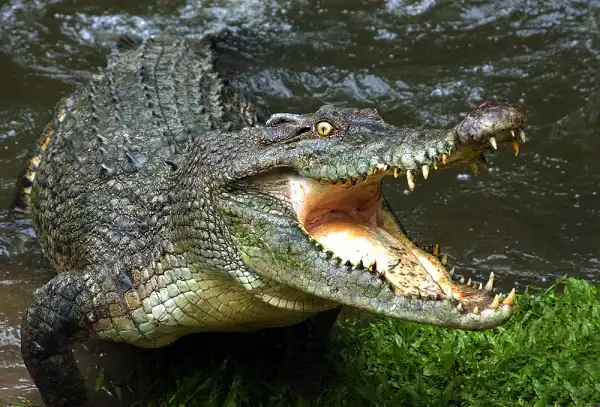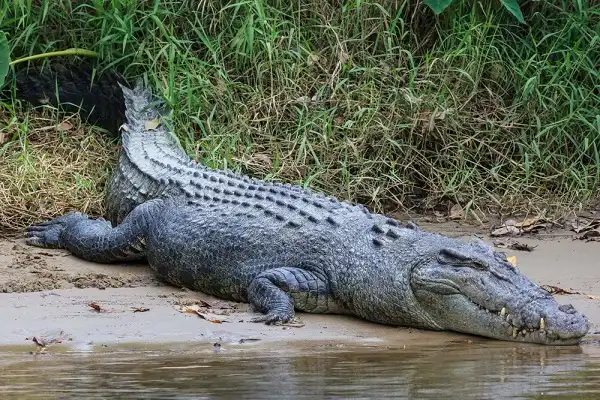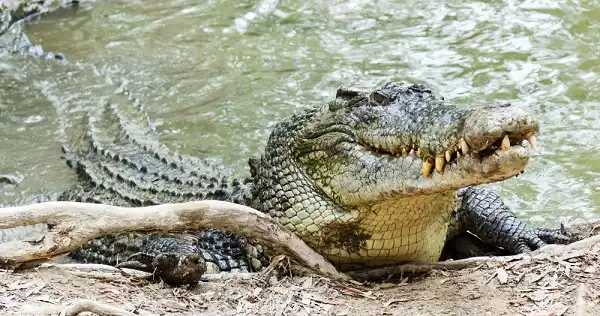Crocodiles are one of the most feared animals in the world. But what do we really know about them? In this blog post, we’ll explore some of the myths and facts about crocodiles. We’ll also learn about their habitats, diet, and how they’re hunted.

Crocodile Description
Crocodiles are large, semi-aquatic reptiles with thick, scaly skin and powerful long tails. They have four short legs and a large head that is flattened with long, sharp teeth. Their powerful jaws are capable of crushing even the toughest shells; some individuals have been recorded biting through steel barrels with ease. On top of this, crocodiles have an acute sense of smell which allows them to detect prey from far distances. Furthermore, crocodiles possess good eyesight both above and below water allowing them to spot potential prey even when submerged. When threatened or confronted by humans they will typically make loud hissing noises or jaw clap in order to warn off any perceived danger. With all these natural defenses it’s no wonder why so many cultures consider crocodiles as revered animals instead of dangerous pests.
Crocodile Habitat
Crocodiles are found in a variety of habitats, from small rivers and creeks to large lakes and swamplands. They prefer still or slow-moving freshwater bodies of water that are warm and shallow, although some species can also be found in brackish or saltwater environments. Crocodiles tend to live close to the shoreline near muddy banks where they can easily climb out of the water to bask in the sun. Habitat selection is largely dependent on seasonal changes, with crocodiles migrating with food sources as temperatures rise and fall. In colder climates, crocodiles may hibernate for extended periods during the winter months. During this time, they will seek out deep holes on land or underwater caves to protect themselves from freezing water temperatures. Crocodiles are territorial animals and will often fight other crocodiles over food sources, basking spots, and nesting areas. Males will fiercely defend their territory against other male intruders while females usually remain solitary unless they are searching for a mate. At certain times of year during breeding season, males may make loud bellowing noises to attract female attention.
Crocodile Diet
Crocodiles are opportunistic predators and their diets vary depending on the region they inhabit and the availability of food sources. Common prey includes fish, amphibians, reptiles, small mammals, and invertebrates such as crabs, mussels, and crayfish. They have also been known to eat larger animals like deer when given the opportunity. Crocodiles will typically swallow their prey whole or in large chunks so that they can digest it more easily. In general, healthy adult crocodiles require a diet consisting mostly of meat; however juveniles may consume some plant matter based on availability. Like most living organisms, proper nutrition is essential for growth and development so it is important for young crocodiles to receive adequate amounts of both protein and carbohydrates in order to reach full maturity. In captivity, diets usually consist of commercial products designed specifically for reptiles as well as fresh fish and vegetables whenever possible.

Crocodile Size
Crocodiles are large animals, ranging in size from the dwarf crocodile (Osteolaemus tetraspis) which grows to a maximum of 6 feet (1.8 meters) in length, to the saltwater crocodile (Crocodylus porosus) which can reach lengths of up to 23 feet (7 meters). The largest species on the planet is the Nile crocodile (Crocodylus niloticus), with males typically measuring 16-18 feet (4.88-5.49 meters) and females averaging around 11-13 feet (3.35-3.96 meters). Overall, despite their enormous size and fearsome reputation, crocodiles are actually quite gentle creatures who will rarely attack humans unless provoked; instead they prefer more docile meals such as fish, amphibians or even birds that come near enough for them to snatch up!
Crocodile Lifespan
Crocodiles are long-lived creatures, with some species living up to 75 years in the wild! There is a wide range of lifespans for different crocodilian species, depending on their size and habitat. For example, saltwater crocodiles (Crocodylus porosus) can live up to 70 years, while smaller species such as the American crocodile (Crocodylus acutus) have been known to reach around 50 years in age. The exact lifespan of each individual crocodilian will also depend on factors such as nutrition, environmental conditions and predation. In captivity, well-cared-for crocodilians may live significantly longer than those living in the wild due to access to better food sources and protection from predators.
One captive Orinoco Crocodile (Crocodylus intermedius) even made it to 110 years old! This incredible record was documented by Guinness World Records and verified by DNA testing. In general, larger species tend to have longer lifespans than their smaller counterparts. This is because they are able to better withstand predators and more easily find food sources that will sustain them over a longer period of time. Studies have also shown that female crocodilians generally outlive males by about 10 years or more due to the fact that they tend to be more aggressive when defending themselves from other predators or scavenging for food.

Crocodile Behavior
Crocodiles are highly social creatures, engaging in a variety of behaviors such as feeding, nesting, and communication with both members of their own species and other animals. During mating season, males may perform elaborate courtship displays to attract a female, which can include growling and displaying the teeth. Crocodiles will also use body language to communicate with one another or to assert dominance or show submission. This may include head bobs, tail slapping, snout rubbing and vocalizations.
Crocodiles often live in groups called pods or congregations that consist of several related individuals. These social structures are key for crocodilian survival as they offer protection from predators and allow them to better locate food sources. In fact, the presence of even just one other crocodile has been shown to significantly reduce predation risk by acting as an effective early warning system against intruders. Though crocodilians generally avoid humans when possible due to fear of retaliation, they have been known to hunt people in areas where they have become habituated to human presence through lack of harassment or intentional feeding activities.
Crocodile Speed
Crocodiles are surprisingly swift and agile creatures in their natural habitats. While they move very slowly on land due to their heavy body armor, they can swim up to 30 miles per hour in short bursts. This impressive speed is made possible by their powerful tails which act as propellers, propelling them through the water with lightning quickness. They can also reach speeds of up to 20mph when crossing open stretches of dry land, and will become even quicker when threatened by a predator or pursuing prey. Though crocodiles usually prefer slow-moving waters such as lakes, rivers, and estuaries, they have been known to venture into choppy open seas in pursuit of food sources or mates. In these environments, the crocodiles streamlined bodies give them an even greater advantage; with their flattened heads and tapered tails, they are able to cut through waves with remarkable ease. Crucially, a crocodile’s speed also depends on its age; juveniles may be quite sluggish compared to adults as they are smaller and less experienced swimmers. As a result, it is not uncommon for adult crocs to outpace younger ones during feeding frenzies or during attempts to escape danger.
Crocodile Hunting
Crocodiles are remarkably successful hunters thanks to their specialized physical adaptations and keen cognitive abilities. While they usually prey on smaller animals such as fish, amphibians, and reptiles, they have been known to hunt larger mammals such as feral pigs and even deer! However, crocs will only attempt these feats when given no other choice due to the relative difficulty of the task. In most cases, crocodiles will stalk their targets from underwater before making a quick surprise attack using powerful jaws and sharp teeths; this strategy allows them to take down unsuspecting prey items without having to expend too much energy in the process. After catching their victims with ease, crocodiles will then drag them into deeper waters where they can be eaten without risk from other predators. If the target is too large for one individual croc to subdue alone, several individuals may join forces in order to overpower it together; this behavior has been observed among Nile crocodiles in particular, who have been observed cooperating with each other during hunts!

Conclusion
Crocodiles are some of the oldest and most successful predators on Earth. Not only do they possess remarkable strength and speed, but their cognitive abilities also enable them to survive in even the harshest environments. Furthermore, these reptiles have been observed displaying complex social behaviors during hunts as well as learning from experience when it comes to locating food sources. All of this has allowed crocodilians to remain a dominant species in many ecosystems throughout the world – a testament to their impressive resilience! It is clear that crocodiles are more than just terrifyingly dangerous apex predators; they are beautiful creatures capable of adapting to new and challenging conditions over time due to their highly developed physical adaptations, keen senses, and sophisticated cognitive skills. With any luck,
Frequently Asked Question

